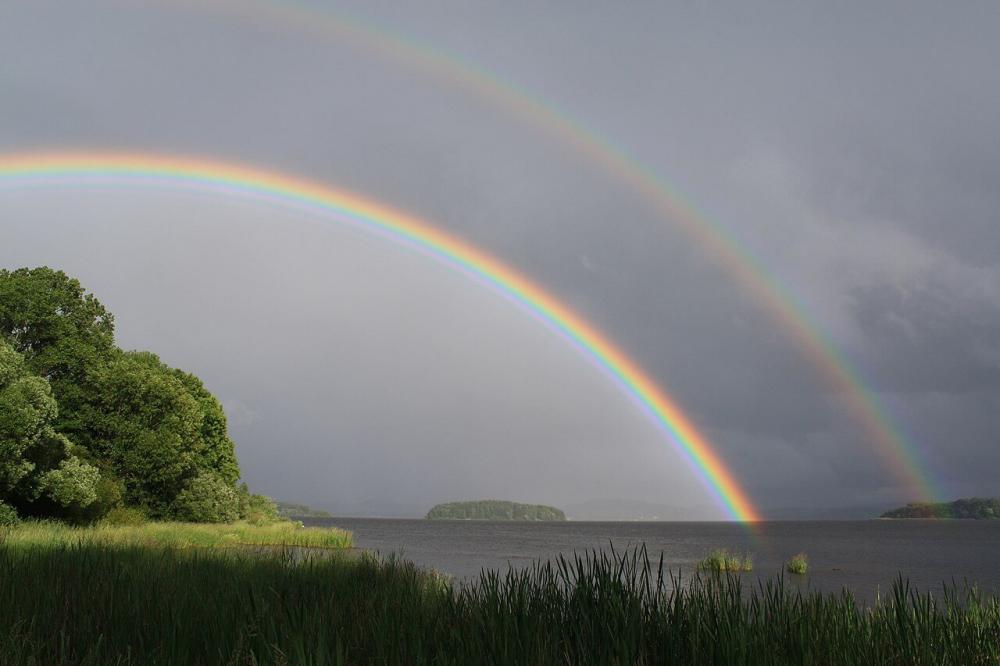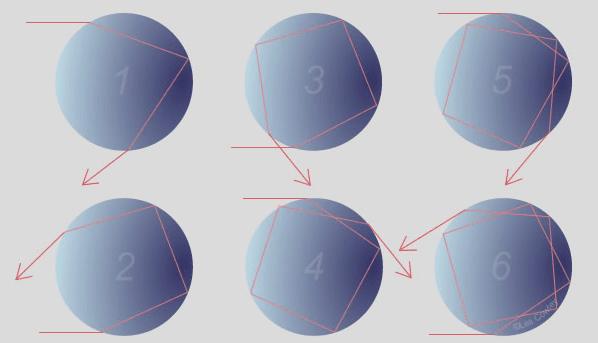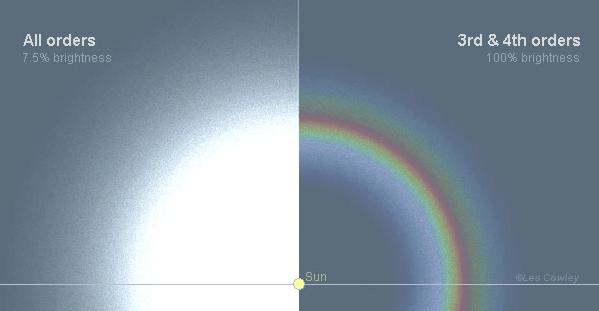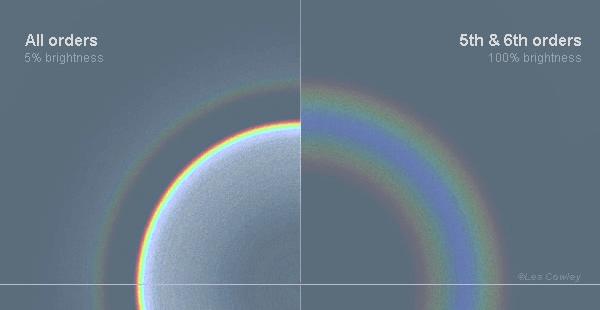Secondary and Higher Order Rainbows
Secondary Rainbows
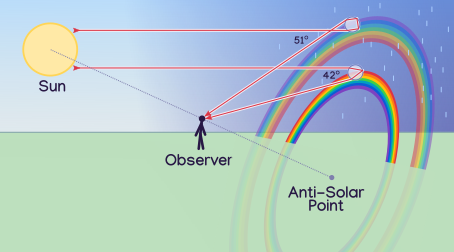
Secondary rainbows with their primaries form what is commonly refered to as a "double rainbow." The secondary rainbow is outside of the primary, fainter and wider than it, with the order of its colors is reversed. It has the same antisolar point as the primary rainbow.
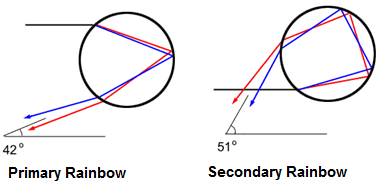
For secondary rainbows, the light is reflected twice (rather than just once) in the water droplets. Most light that enters a drop passes through it without reflection, but a few do reflect. For those that reflect most exit, but a few of those go on to reflect again, this is why secondary rainbows are much fainter than pirmaries, since so much light is lost. The second reflection is also what reverses the color order compared to the primary's. Secondary: red on inner edge and violet on outer edge, primary: red on outer edge and violet on inner.
Since the sunlight reflects twice within the drop before it exits, the exiting colors form a different angle upon exit than they do for primary rainbows, with red at 50 and violet at 53 degreesLibreText Physics. In order for the light to hit the viewers eyes, the drops must be different ones than those that make the primary rainbow, making a larger cone outside of the primary rainbow cone.
Every primary rainbow has a secondary rainbow, however lighting conditions often make them difficult to see.
Unlike primary rainbows, secondary rainbows have a faint glow of white light on the outside of its cone (compared to the glow of light on the inside of the primary rainbow cone). Alexander's Dark Band - AtOpt



Since both the glow and order of the colors is reversed, violet yet again is the most diluted color, with red being the purest.
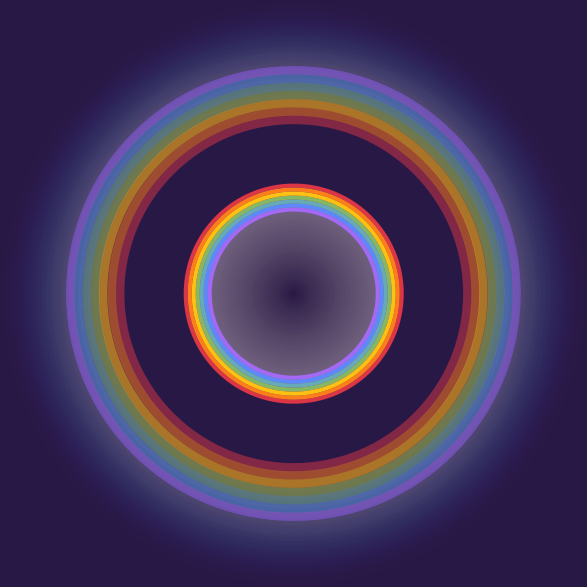
Because there is white glow outside the secondary and inside the primary, there appears to be a dark band between the primary and secondary rainbows, which is called Alexander's dark band. This band isn't actually darker than the rest of the sky, its just an illusion because it looks so dark in comparison to the glow inside the primary and the glow outside the secondary. Even in this illustration it appears darker than the background in the corners, but it is not.
Higher Order Rainbows
Not only are there secondary rainbows, but there are also higher order rainbows. In these terms a primary rainbow is the first order rainbow and a secondary rainbow is the second order rainbow. The order refers to how many reflections within the droplet occur before the light exits the droplet to create the rainbow. Primary (first order) rainbows have only one reflection, secondary (second order) rainbows have two reflections, and third order rainbows would have three reflections within the droplet. Considering with each reflection, light passes through the droplet and is lost, the higher order the rainbow, the fainter it will be. Hence, you can't see more than the secondary rainbow with your naked eye (image enhancement however can reveal them in photographs).
The third order rainbow is at 42.5 degrees around the sun, and its colors are in standard order (primary order). The fourth order rainbow is just ouside of the third, its colors in reverse order. Interestingly, third and fourth order rainbows are centered around the sun rather than the antisolar point. Because of this, the brightness of the sun prevents any chance of seeing the 3rd and 4th order rainbows with the human eye.
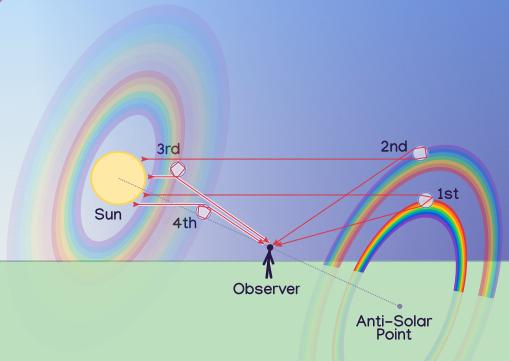
With the first and second order rainbows, the light exits the drop on the side it came from, thus it has to reflect from a drop past the viewer and to reflect back to the viewer. On the other hand, for third and fourth rainbows, the light exits the drop on the opposite side it entered, almost as if the light traveled a straight path (but it was angled some), thus the drops they exit from have to be between the sun and the viewer for the light to reach the viewer.
Even fainter than 3rd and 4th order rainbows, 5th and 6th order rainbows cannot be seen by the human eye either. They are also much wider. Unlike 3rd and 4th order rainbows, 5th and 6th do center around the antisolar point. Notice how sunlight exits them from the same side it entered, in the drop diagram. The fifth order rainbow is between the second and first order rainbows, and the sixth order rainbow is right below the first order rainbow.
You may have noticed that as the order increases, so does the width of the rainbow, this is due to the angle that the sunlight enters the raindrop and refraction. In first order rainbows the sunlight enters the drop closest to the center of the drop out of all orders, and as the order increases the sunlight enters closer to the edge of the drop. Close to the edge, the sharper the "angle" the air and water make with each other, and as the angle increases, the more of an angle the light is refracted. With greater refraction, the wider the colors disperse from each other, making wider rainbows. Secondary Rainbows - Oikofuge
Zeroth Order Glow
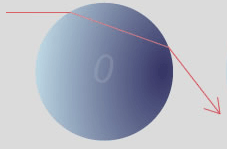
There is a zeroth order, featuring no reflection, just refraction, however it is not a rainbow, rather just a glow of light that makes the sun appear like it is brighter than usual. This occurance along with the sun's own brightness make it difficult to see third and fourth order rainbows.
Why don't zero order rays create rainbows?
This diagram illustrates rays of light that pass through a raindrop (right) and rays that reflect once off the back of a drop before exiting (bottom left). Notice how the zeroth order rays flare out, but after the first reflection the first order rays hit a hard line where they go back up. This line is the minimum angle of deviation where most of the rays cluster around (it is at 42 deg for red light and 40 for violet).
This hard line only occurs with light reflected within the drop. This dense concentration of light (called a caustic) forms a circular shape for each color (actually a cone, but we only see it head on). Without a caustic for each wavelength, all the colors overlap and wash each other out, creating white again.


Here are some zeroth order colors, and how they overlap to form a glow of white light. (The illustration is more pink due to being a rough visual guide).
Suggested Next Pages: Reflection Rainbows Supernumerary Rainbows
